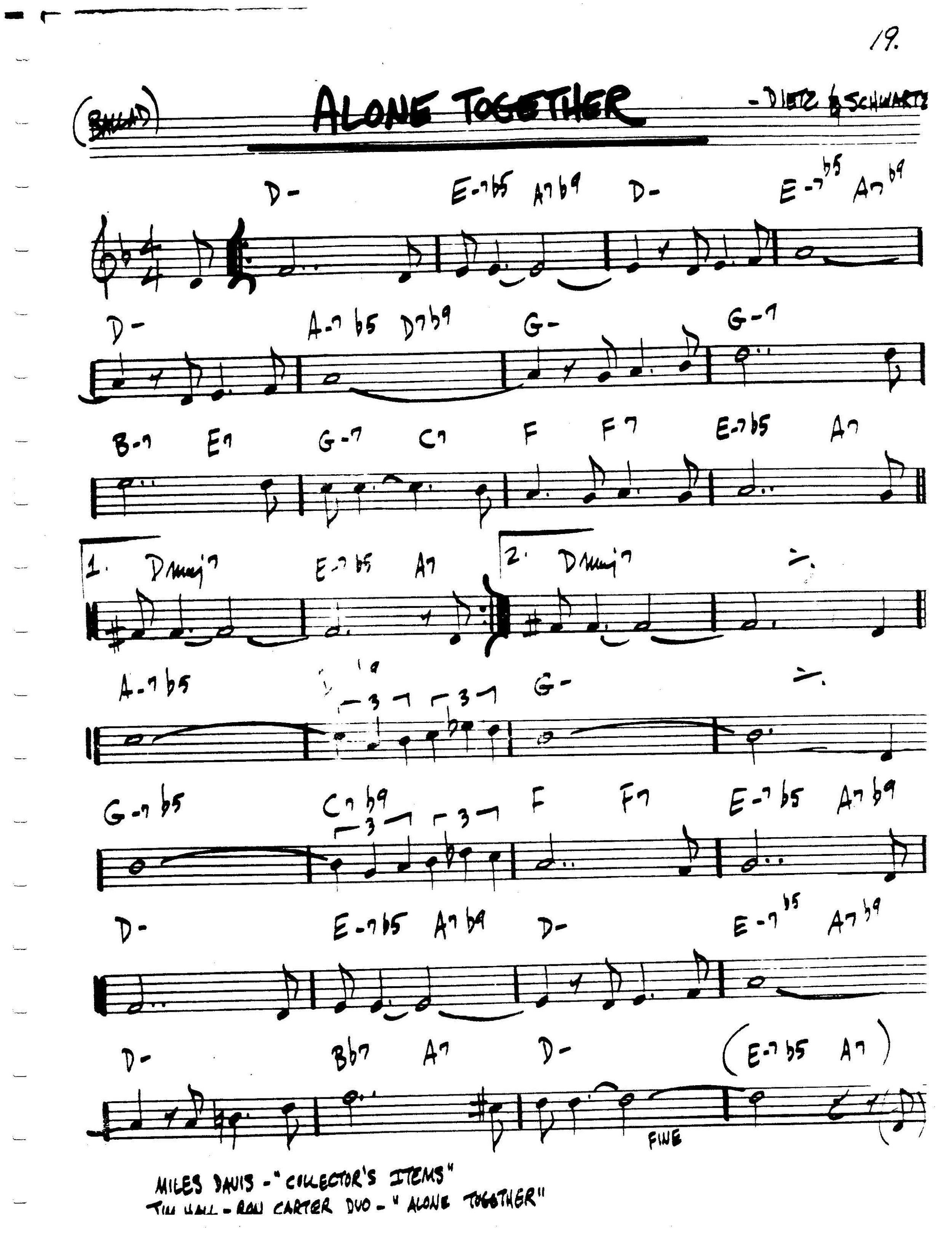Alone Together - Thematic Practice
Here is another concept to consider adding to your practice arsenal. It falls broadly under the umbrella of giving yourself a "goal" for any given solo, not unlike the last post on Falling Grace, where we looked at building your solos in a specific direction. Here, we start with a two note motif and see how long we can sustain it, giving some liberties to deviate, but also an obligation to return to it. See video below for a demonstration.
As always, the objective of practicing this way is to force yourself to think about "constructing" a solo rather than just playing whatever comes to mind. I think a more organized, goal-oriented, approach during practicing helps hone your instincts when you're just letting loose, so that what comes out even then will be imbued with more structure. Which will be more listenable because the listener will be able to follow along.
Harmonically, Alone Together is pretty engaging. Composed in 1932 for the musical revue, Flying Colors, by Arthur Schwartz, the tune is a great exploration of the D minor key, including blues concepts, applied dominants, parallel major vs. minor, relative major vs. minor, and brief modulations. The form is AABC. Here's how I would learn it section by section.
A:
Bars 1-4: Here you start out in D minor alternating between I and some II-Vs. Very standard minor cadences.
Bars 5-8: Starts in D minor but starting in the second bar you transitioning to G minor via an applied II-V.
Bars 9-10: A surprise sojourn in A major! Very bright sounding as you traverse the subdominants/dominants of A major and F major. Here I’m just thinking major scales, and because these are II-Vs, the 4th and 7th degrees (Fa and Ti; A: D and G#, F: Bb and E) are appropriate. You can also outline the II-V chord tones here as many people do, but if you’re trying to develop themes, it can be useful to understand how to use a broader palette.
As I’ve written about earlier, there are many exercises to get facile connecting disparate keys (A major and F major/D minor in this case). A favorite of mine is just to set the metronome and play consecutive eighth notes up for a bar of one key, and connect to the nearest scale tone of the next, continuing in this manner until I’ve gone as high as possible, then come down doing the same thing.
Bars 11-14: You land in F (relative major of D minor) and move to D via a minor II-V, but you land in D major! Again, very bright sounding against the heavy D minor material established earlier in the section. Another II-V brings you back to D minor at the top of the form.
B:
Here I think in F major. The first 4 bars are a long II-V of II. The second 4 bars are a long II-V of I (F major).
A quick II-V brings you back to D minor to begin the C section.
C:
Bars 1-4 (of C section): This starts out like A but omits the G minor material.
Bars 5-6: You are still in D minor, and the melody prominently states a B natural. I try to emphasize this note in my solos, as I think it’s a very neat sound against the many B flats in the melody and harmony. Very bluesy sound when combined with the foundational F, E, D (Me, Re, Do) sound in D minor.
Bars 7-8: Here we have Bb7 going to A7 before resolving to D minor. Standard theory would have you analyzing the Bb7 as a “tritone sub” or “Sub V” going to A7 (i.e. a tritone sub for E7alt). Given how little time you actually spend on the Bb7 however, I tend to think one of two things:
The “leading tone” to A7, or G# (or Ab, the 7th of Bb7) is actually just a blue note in D minor - just play blues here! I’ve transcribed enough stuff to feel “authentic” doing this.
Treat it like another standard cadence in D minor. Sounds fine.
If you overthink this part, it’s very likely you’ll end up sounding mechanical. The melody of the tune, simple as it is, gives you a lot of solid guidance
Of course, learn the melody and lyrics cold. Once those are internalized and you’ve absorbed the harmony, the harmonic framework becomes really simple… “start in D minor and then you go to G minor. Couple quick II-Vs in A (non-resolving) and F then back to D but this time D major. Repeat. Bridge: II-V to II and II-V to I in F. End with some D minor material but make it bluesy with major blues (B natural) followed by minor blues (Ab).”
Weather is hopefully starting to round a corner here in Chicago. Looking forward to having a darker tan in future videos.

